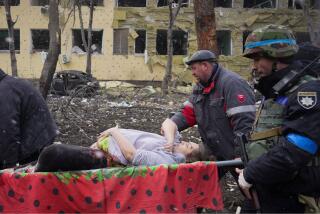Movie Reviews : ‘Powaqqatsi’ Offers Feast of Sight and Sound
- Share via
Godfrey Reggio’s “Powaqqatsi” (selected theaters), like his earlier “Koyaanisqatsi,” is a lyrical documentary that turns the instruments of technology against it. In some ways, the new film is less effective, but it’s also more visually spectacular: a mesmerizing cascade of sensuous sights and sounds.
Shot on several continents--in Peru, Brazil, Kenya, Egypt, Israel, Hong Kong, Nepal, India, West Germany and France--”Powaqqatsi” creates its own global village, linking it all with the hypnotic repetitions of Philip Glass’ score. And instead of “Koyaanisqatsi’s” focus on geography and the mechanical, “Powaqqatsi” shows a new fascination with the human face--usually from the Third World, usually poor.
These are people at work, people in transit, people cast off on the shoals of the cities, with faces alive and buoyant, or dead and shattered. Over and over, we see shots of water, of landscapes parched or exploding with heat. The thousands of faces seem drenched in light, blazing, joined together in a mass communion with the sun.
One of the more powerful images in the film is a tiny boy walking along a highway, heat rising in waves and the crushing mass of a truck swallowing up the rest of the frame. Later we see a wrecked car on a highway divider and ghostly superimpositions of other cars racing by on either side. Both frames suggest a leading theme: the domination of man by his tools, the tyranny over humanity by its extensions.
Koyaanisqatsi is a Hopi word meaning “life out of balance.” “Powaqqatsi” refers to a life lived at others’ expense, a life of exploitation. The subject matter is less cosmic, more personal and elusive--and, as before, there’s a paradox.
Reggio attacks the excesses of modern life by using one invention--the motion picture camera--which seems most typical of the new technology. And he consciously distorts many of his images, speeds them up, slows them down, uses time lapse photography and--especially in “Powaqqatsi”--opticals and telescopic lenses.
Majestic mesas tower up against scudding, racing clouds in “Koyaanisqatsi,” and in “Powaqqatsi” rapturously slowed bodies swim through lacquered-looking sunlight. With his new cameramen, aerial photography specialists Graham Berry and Leonidas Zourdoumis, Reggio creates the illusion of a godlike technological eye, watching over the eternal seas and hills, the mad hubbub of the cities.
Glass’ score, as before, knits together the images and gives them resonance. Here, the music is more complex and various, with an insistent percussion that suggests heavy metal mixed with a plangent stew of ethnic instruments, winds, strings and a children’s chorus.
Is “Powaqqatsi” (MPAA-rated: G) a matter of personal taste? Reggio’s sensibility--mixing spirit and machine, meditation and pop, idealism and iconoclasm, the universal and the particular, the symbolic and the real--seems at times a kind of ‘60s revival. But, even so, Reggio and Glass offer something that most narrative movies or documentaries can’t: a true feast for the eyes and ears.
More to Read
Only good movies
Get the Indie Focus newsletter, Mark Olsen's weekly guide to the world of cinema.
You may occasionally receive promotional content from the Los Angeles Times.










